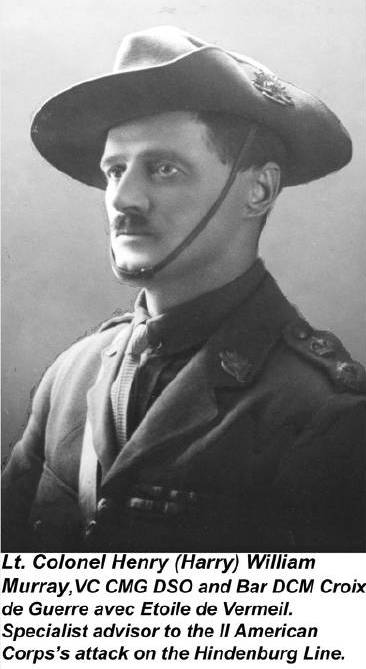
 |
The most decorated allied soldier of WW1 - Harry Murray VCbut he was he actually a MacGregor.A descendant of James MacGregor, Dean of Lismore, in Fortingall |
|
The great grandparents of Harry Murray VC, were Kennedy Murray and Ann White. Ann White had been transported to Australia in 1790 on the hellish, ‘death ship’ Neptune, while Kennedy Murray came the following year on the convict ship, The Pitt. They survived their harrowing ocean journey to Botany Bay and life on Norfolk Island and Van Diemen’s Land. |
 |
With the opportunity of a new land, and with resolve, tenacity and determination, they rose up from their poor convict status to become honest and productive citizens of the new colony. Their great grandson, Harry Murray VC is testimony of their courage and achievements. |
|
Harry Murray was born near Evandale on December, 1, 1880 and before leaving for adventure on the Goldfields in Western Australia, he worked on his parents’ farm. |
 |
He enlisted in 1914 in Western Australia as a private and by 1918 was a Lt. Colonel in command of his own machine gun battalion that took part in the famous Battle of Hamel. The official history of the 16th Battalion reports: “To Murray belongs the honour of rising within three and a half years from a machine-gun private to the command of a machine-gun battalion of 64 guns, and of receiving more fighting decorations than any other infantry soldier in the British Army in the Great War — rewards and decorations every one of them richly deserved”. With the 16th Battalion he landed on April, 25, 1915, at Gallipoli and immediately went into action as a machine gunner on Pope’s Hill. He was involved in most of the major encounters with the Turks and earned a DCM. On the Somme in France he continued to show resolve and fortitude under great pressure and difficult circumstance. But what the other diggers noticed about Harry Murray was his comradeship, leadership skills, stoicism, respect for discipline, the care for the well being of his men and his unwavering bravery, so much so that it was considered that nobody could be that brave so he must be mad, hence the title, ‘Mad Harry’. He received the VC for his actions on February 4 and 5, 1917 at Stormy Trench, Gueudecout, France. After a bloody attack the position was captured and during a 48 hour battle, three severe counter attacks by the enemy were beaten off. “By sheer valour he made his presence felt throughout the line, encouraging his men, heading bombing parties, leading bayonet charges and carrying wounded to safety. His magnificent example inspired his men throughout”. (London Gazette; March 10, 1917) Once again on the Western Front he took part in many of the minor and major battles against the Germans and was as a consequence wounded several times. On returning to Australia on the same ship as General Birdwood and General Monash, Harry Murray VC was given a heroes welcome. The newspapers at the time reported that Murray was carried by the Diggers through the streets of Fremantle to applause, whistles and cheers showing their appreciation of his amazing exploits. A genuinely retiring man who shunned the limelight he became a grazier and family man on his property in Richmond, Queensland. To honour the military feats of this great Anzac, a bronze statue of him in action at ‘Stormy Trench’, was unveiled by the Governor General in 2006 in the main street of Evandale, Tasmania. A descendant, Anne Batalbasi, stands beside the monument. From an article printed on April 25, 2013 in the Examiner, an Australian Newspaper https://www.examiner.com.au/story/1456509/convicts-grandson-to-national-hero/ |
|
So why does the Clan Gregor commemorate a story about a heroic Murray? The answer is that recent Y-chromosome DNA tests of his descendents have shown that they are actually MacGregors and not Murrays. His family have been traced back to a John Murray who married Elizabeth Calder in 1771. They were both servants to the Countess of Eglintoune at Dundonald in Ayrshire. Their son Kennady, was born in 1771 and transported to Van Diemen’s Land in 1791 for petty theft. When one of Harry's descendants received the surprising news that his DNA test had shown that he was really a MacGregor, he approached the Clan Gregor Society for assistance. After some detective work comparing with other DNA results, we traced Kennedy Murray's ancestors back to Perth where the alias Murray had been adopted by a David MacGregor following the proscription of the MacGregor name initiated by King James VI in 1603. The family in Perth descended from James MacGregor, the Dean of Lismore, who resided at Fortingall, Glen Lyon. http://glendiscovery.com/gregor-genealogy-83.html |